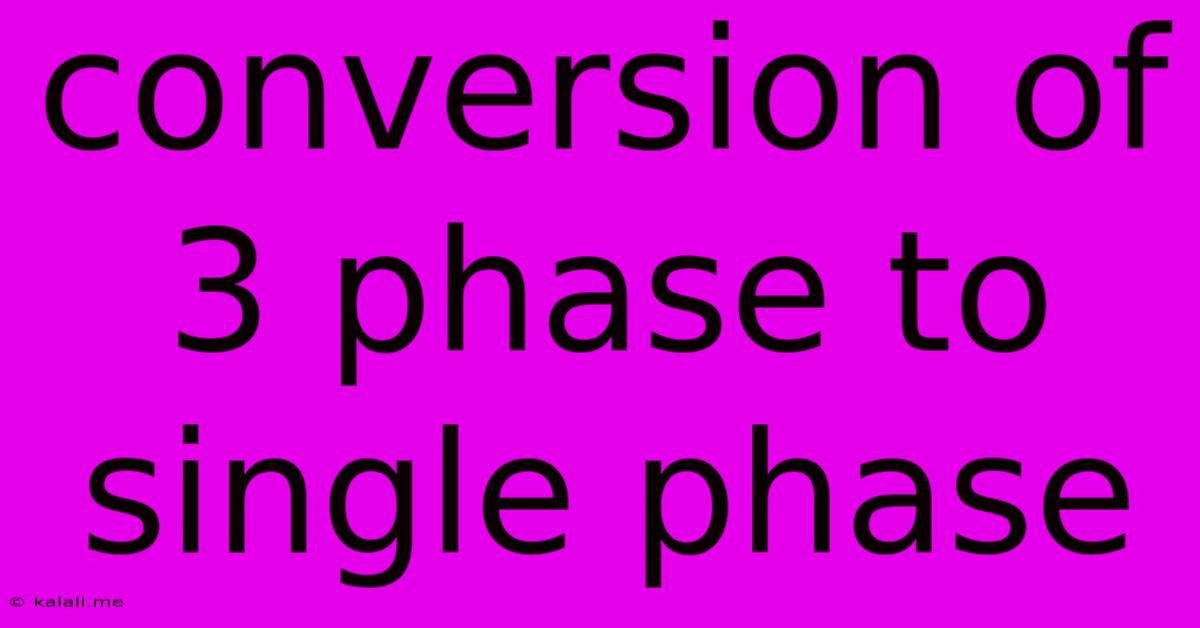Conversion Of 3 Phase To Single Phase
Kalali
May 19, 2025 · 4 min read

Table of Contents
Converting 3-Phase Power to Single-Phase: A Comprehensive Guide
Meta Description: Learn how to safely and effectively convert three-phase power to single-phase power. This guide covers various methods, including transformers, converters, and considerations for safety and efficiency. Understand the implications and best practices for your specific application.
Converting three-phase power to single-phase is a common requirement in many industrial and residential settings. Whether you need to power a single-phase appliance in a three-phase environment or have a limited power supply and need to utilize it efficiently, understanding the methods and considerations is crucial. This guide will walk you through the various techniques, highlighting the pros and cons of each.
Understanding 3-Phase and Single-Phase Power
Before diving into conversion methods, it's essential to understand the difference between three-phase and single-phase power. Three-phase power uses three alternating current (AC) waveforms, each 120 degrees out of phase with the others, resulting in a more constant power delivery. Single-phase power, on the other hand, uses only one AC waveform. Three-phase systems are generally more efficient for higher power applications, while single-phase is sufficient for lower power needs like household appliances.
Methods for 3-Phase to Single-Phase Conversion
Several methods exist for converting three-phase power to single-phase. The optimal method depends on factors like power requirements, budget, and the level of technical expertise available.
1. Using a Single-Phase Transformer: This is the most common and often the simplest method. A single-phase transformer is connected to two of the three phases of the three-phase supply. This method is suitable for lower power applications and provides a relatively straightforward conversion. However, it's crucial to choose a transformer with the correct voltage and amperage rating to avoid overloading and potential damage. The selection of which two phases to use can impact the overall balance of the three-phase system, so this should be carefully considered, particularly in larger industrial settings.
2. Scott-T Transformer Connection: For higher power applications requiring a more balanced load on the three-phase system, a Scott-T transformer connection is a more sophisticated method. This configuration uses two transformers to efficiently convert the three-phase power to single-phase. It offers improved efficiency and balanced load distribution compared to simply tapping two phases with a single transformer. This method requires a deeper understanding of transformer configurations and is generally suited for more complex installations.
3. 3-Phase to Single-Phase Converter: Electronic converters offer a more modern approach to the conversion. These devices utilize sophisticated circuitry to convert the three-phase AC power to single-phase AC power. They often include features like voltage regulation and power factor correction, providing greater control and efficiency. This method is suitable for applications where precise voltage control and high efficiency are required, but they can be more expensive than using transformers.
Safety Precautions and Considerations
Regardless of the chosen method, safety is paramount. Working with high-voltage electricity requires proper training and precautions. Always:
- Consult with a qualified electrician: Attempting to convert three-phase to single-phase without adequate expertise can be extremely dangerous.
- Disconnect the power supply: Before working on any electrical equipment, ensure the power is completely disconnected.
- Use appropriate safety equipment: This includes safety glasses, insulated gloves, and other protective gear.
- Understand the voltage and amperage ratings: Ensure all equipment is appropriately rated for the voltage and current being handled.
Choosing the Right Method: A Summary
The best method for converting three-phase to single-phase depends on your specific needs. Consider the following factors:
- Power requirements: How much power does your single-phase load need?
- Budget: Transformers are generally the most cost-effective option, while converters can be more expensive.
- Efficiency requirements: Converters generally offer higher efficiency.
- Technical expertise: Simple transformer connections require less expertise than Scott-T configurations or electronic converters.
By carefully considering these factors and adhering to safety precautions, you can successfully and safely convert three-phase power to single-phase for your application. Remember, seeking professional assistance from a qualified electrician is always recommended, especially for larger installations or if you lack experience with electrical work.
Latest Posts
Latest Posts
-
Key Will Not Come Out Of Lock
May 19, 2025
-
How To Get Diesel Smell Out Of Clothes
May 19, 2025
-
How To Say With In German
May 19, 2025
-
How To Stop Creaking Floors Under Carpet
May 19, 2025
-
When Is Beauty And The Beast Set
May 19, 2025
Related Post
Thank you for visiting our website which covers about Conversion Of 3 Phase To Single Phase . We hope the information provided has been useful to you. Feel free to contact us if you have any questions or need further assistance. See you next time and don't miss to bookmark.